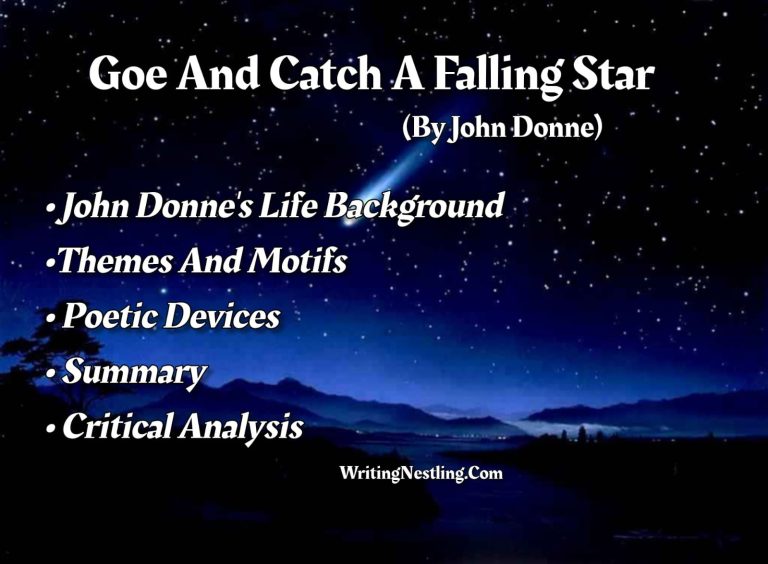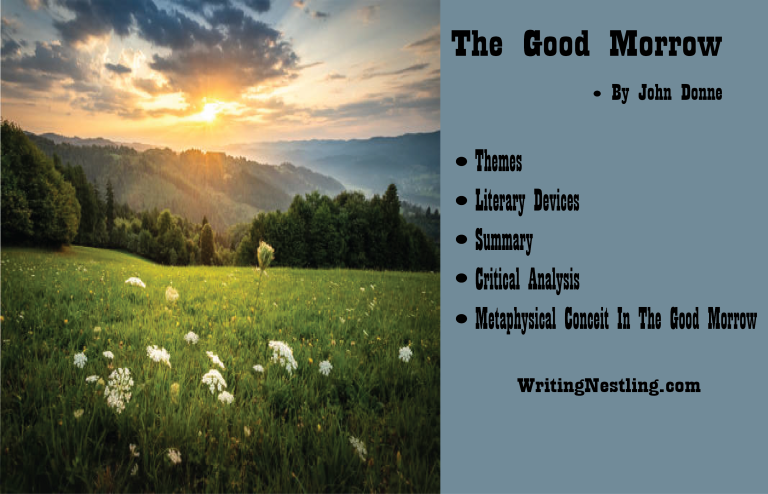A Valediction Forbidding Mourning (Themes, Summary, Critical Analysis)
“A Valediction: Forbidding Mourning” by John Donne stands as a masterpiece of metaphysical poetry, showcasing the poet’s intellectual depth and profound exploration of love.
Written during the early 17th century, a time marked by religious and political upheaval in England, Donne’s poem goes beyond conventional expressions of farewell, offering a unique perspective on separation and the enduring nature of true love.
Through intricate metaphors, particularly the renowned compass conceit, Donne artfully depicts the spiritual unity between lovers, challenging traditional views on mourning and presenting their parting as a virtuous and harmonious event.
The poem’s formal elegance, characterized by a disciplined structure and rhythmic precision, complements its intellectual rigor, creating a work that not only captivates with its linguistic artistry but also delves into the complexities of human connection, spirituality, and the transcendent power of love.
John Donne’s life and literary context
John Donne, born in 1572, was a prominent English poet and cleric during the Renaissance period. His life unfolded against the backdrop of profound social, religious, and political changes in England.
Donne’s early years were marked by a Catholic upbringing, and he faced challenges due to his religious beliefs in a predominantly Protestant society. His education at Oxford and later at Cambridge exposed him to the intellectual currents of the time, shaping his mind as a scholar and poet.
Donne’s literary journey underwent a notable transformation. Initially, his poetry reflected the conventions of Elizabethan love poetry, characterized by elaborate metaphors and courtly expressions.
However, as Donne matured, he embraced the metaphysical style, a distinct poetic movement marked by intellectual intricacy, wit, and exploration of profound philosophical themes. His poems are known for their innovative use of metaphors, complex conceits, and a deep engagement with matters of love, spirituality, and human connection.
In addition to his poetic pursuits, Donne’s career also led him to the church, where he eventually became a priest. His later works often intertwine his religious convictions with his poetic sensibilities, creating a unique blend of the secular and the sacred.
John Donne’s life and literary context offer a fascinating glimpse into the rich tapestry of Renaissance England, where the interplay of religious tensions, intellectual fervor, and poetic innovation converged to shape the legacy of one of its most remarkable poets.
Themes and Motifs
Themes and motifs are recurring elements or ideas in a literary work that contribute to its overall meaning, coherence, and depth. Let’s explore these concepts in the context of literature:
Themes
Themes are fundamental and often universal ideas or messages that are explored in a literary work. They provide insight into the author’s perspective on human nature, society, or the world. In “A Valediction: Forbidding Mourning” by John Donne, some prominent themes include:
Love and Spirituality
The poem delves deeply into the nature of love, emphasizing a spiritual connection that transcends physical separation. It explores the idea that true love is not solely dependent on physical proximity but is elevated to a higher, metaphysical realm.
Metaphysical Exploration
As a metaphysical poem, Donne’s work often engages with complex and abstract ideas. The exploration of metaphysical conceits, such as the compass metaphor, reflects the theme of intellectual and spiritual depth in the poem.
Virtuous Parting
The poem challenges conventional views of parting and mourning, presenting the idea that a separation can be virtuous and harmonious, akin to the orderly movements of celestial bodies.
Motifs
Motifs are recurring symbols, images, or ideas that contribute to the development of a theme. In “A Valediction: Forbidding Mourning,” several motifs stand out:
The Compass Metaphor
The primary motif in the poem, the compass metaphor serves as an extended analogy for the lovers’ relationship. It conveys the idea that, like the legs of a compass, the souls of the lovers remain connected even when physically apart.
Celestial Imagery
References to celestial bodies, such as the sun and stars, are recurring motifs. These images underscore the timeless and cosmic nature of the love being described, emphasizing its spiritual and enduring qualities.
Alchemical References
The poem incorporates alchemical imagery, such as the reference to gold, which symbolizes the purity and value of the love shared between the speaker and the lover. This motif adds layers of meaning to the exploration of their connection.
Understanding themes and motifs in a literary work enhances the reader’s appreciation for the depth and complexity of the text, allowing for a more nuanced interpretation of the author’s intentions.
Poem’s formal structure and rhyme scheme
The formal structure and rhyme scheme of “A Valediction: Forbidding Mourning” contribute significantly to the poem’s overall impact and thematic resonance. Composed of nine four-line stanzas, known as quatrains, the poem adheres to a consistent structure, fostering a sense of balance and order.
Each quatrain follows a rhyme scheme of ABAB, contributing to the poem’s musicality and creating a harmonious flow. This regularity in structure reflects the speaker’s assertion of the orderly and virtuous nature of their parting, akin to the predictable and rhythmic movements of celestial bodies.
The poem’s use of iambic tetrameter, with four stressed syllables per line, further enhances its formal elegance. Donne’s skillful manipulation of meter, along with the disciplined rhyme scheme, underscores the intellectual precision and control that characterize metaphysical poetry.
The deliberate and measured rhythm contributes to the poem’s overall sense of stability and rationality, reinforcing the speaker’s argument that the lovers’ separation is not a cause for sorrow but rather a manifestation of their elevated and enduring love.
Moreover, the consistent structure and rhyme scheme act as a counterpoint to the poem’s complex metaphysical conceits and abstract ideas. The disciplined form provides a framework within which the intricate intellectual exploration of love and spirituality can unfold, offering readers a balance between the tangible and the abstract.
In essence, the formal elements of the poem not only enhance its aesthetic appeal but also serve as a foundation for the profound thematic content, creating a work of art that seamlessly integrates structure and meaning.
Summary Of The Poem A Valediction Forbidding Mourning
A Valediction Forbidding Mourning by John Donne is a metaphysical poem that explores the nature of true love and the spiritual connection between two individuals. The poem is structured as a farewell message from the speaker to his departing lover. Rather than lamenting their separation, Donne presents a positive and profound perspective on parting.
The central metaphor in the poem is the compass, where one leg represents the speaker’s physical presence, and the other leg symbolizes the absent lover.
The compass metaphorically illustrates the strength and flexibility of their love, suggesting that physical distance cannot diminish the emotional and spiritual bond between them. The speaker reassures the lover that their separation is only temporary and that their souls remain connected on a deeper, metaphysical level.
Donne employs various metaphysical conceits, including references to celestial bodies and alchemical processes, to convey the transcendental and spiritual aspects of their love. The poem emphasizes the idea that true love is not dependent on physical proximity but is instead strengthened by the spiritual unity of kindred souls.
In the final stanzas, Donne celebrates the virtuous nature of their parting, comparing it to the movements of heavenly bodies that are harmonious and purposeful. The speaker encourages the lover to embrace the separation without sorrow, as their love transcends the physical realm and is elevated to a spiritual plane.
In essence, “A Valediction: Forbidding Mourning” is a profound meditation on love that moves beyond the conventional expressions of grief associated with farewells. Donne’s intricate use of metaphors and metaphysical conceits elevates the poem to a contemplative and intellectual exploration of the enduring nature of true, spiritual love.
Critical analysis Of A Valediction Forbidding Mourning
Critical analysis of “A Valediction: Forbidding Mourning” by John Donne reveals a rich tapestry of metaphysical conceits, intellectual depth, and a nuanced exploration of love. One key aspect that critics often emphasize is Donne’s use of complex metaphors, particularly the compass metaphor that runs throughout the poem.
The comparison of the lovers to the legs of a compass showcases Donne’s ability to weave intricate conceits, illustrating the enduring connection between the souls of the lovers even when physically apart. Critics often applaud the ingenuity of this metaphor, noting how it encapsulates the speaker’s perspective on love as a spiritual and intellectual union that surpasses the limitations of the physical world.
The theme of spiritual love is a focal point of critical analysis. Donne, a master of metaphysical poetry, seamlessly integrates elements of divine and earthly love in the poem.
The celestial imagery, references to alchemy, and the overall transcendent tone contribute to the exploration of a love that is both human and divine. Critics delve into the spiritual dimensions of the poem, examining how Donne challenges conventional notions of love and mourning, proposing a vision of love that is profound, enduring, and almost transcendent in its nature.
The formal aspects of the poem also attract critical attention. Donne’s meticulous use of iambic tetrameter, the ABAB rhyme scheme, and the consistent quatrain structure demonstrate a disciplined craftsmanship that complements the intellectual rigor of the metaphysical conceits.
Critics often highlight how the form of the poem serves as a vessel for its complex content, providing a sense of order and balance to the intricate ideas being explored.
Moreover, the poem’s historical and cultural context adds layers to critical analysis. Donne lived during a period of religious and political upheaval in England, and critics may consider how these influences shape the poem’s themes and the poet’s perspective on love, separation, and the spiritual dimension of human connections.
In conclusion, critical analysis of “A Valediction: Forbidding Mourning” involves a deep exploration of Donne’s metaphysical conceits, the interplay of earthly and divine love, the formal elements of the poem, and its historical context. It is through this multifaceted examination that the richness and complexity of Donne’s poetic genius come to light.
Frequently Asked Questions (FAQ) about A Valediction Forbidding Mourning
What is the central theme of A Valediction Forbidding Mourning?
The central theme of the poem revolves around the nature of true love, exploring its spiritual dimensions and the idea that a genuine connection between lovers transcends physical separation.
What is the significance of the compass metaphor in the poem?
The compass metaphor is a central conceit in the poem, symbolizing the enduring connection between the speaker and the lover. It illustrates the idea that, like the legs of a compass, their souls remain linked even when physically apart.
How does John Donne challenge conventional views of mourning in the poem?
Donne challenges conventional mourning by presenting the idea that the lovers’ separation is not a cause for grief but, rather, a virtuous and harmonious event. He emphasizes the spiritual unity of their love, making mourning unnecessary.
What role does celestial imagery play in A Valediction Forbidding Mourning?
Celestial imagery, including references to the sun and stars, is used to underscore the timeless and cosmic nature of the love depicted in the poem. It adds a layer of transcendence to the exploration of the spiritual connection between the lovers.
How does the poem’s form and rhyme scheme contribute to its meaning?
The consistent quatrain structure, ABAB rhyme scheme, and iambic tetrameter contribute to the poem’s formal elegance. They provide a rhythmic flow and a sense of order, acting as a balanced framework for the exploration of complex metaphysical ideas.
What is a metaphysical conceit, and how does Donne employ it in this poem?
A metaphysical conceit is an extended metaphor that draws a comparison between two seemingly dissimilar things. Donne employs the compass metaphor as a metaphysical conceit, using it to illustrate the profound and enduring nature of the love between the speaker and the lover.
How does the historical context of John Donne’s life influence this poem?
Donne lived during a time of religious and political turmoil in England. The poem can be seen as a reflection of these influences, as well as an exploration of love and spirituality in the context of the larger metaphysical poetry movement.
What is the significance of alchemical references in the poem?
The alchemical references, such as the mention of gold, symbolize the purity and value of the love shared between the speaker and the lover. These references contribute to the overall metaphorical richness of the poem.
How does the poem challenge traditional notions of love and separation?
The poem challenges traditional views by presenting separation not as a cause for sorrow but as a virtuous and harmonious event. It suggests that a deep, spiritual connection between lovers can withstand physical distance.
How has A Valediction Forbidding Mourning been received by literary critics over time?
Critical reception has been generally positive, with critics praising Donne’s intellectual depth, metaphysical conceits, and the poem’s unique exploration of love and spirituality. Interpretations may vary, but many recognize its enduring appeal and complexity.
Conclusion
In conclusion, “A Valediction: Forbidding Mourning” by John Donne stands as a testament to the poet’s ability to weave intellectual intricacy and emotional depth into a profound exploration of love. Donne’s unique metaphysical conceits, exemplified by the compass metaphor, transcend the conventional boundaries of love poetry.
The poem challenges societal norms by portraying separation not as a cause for mourning but as a virtuous and spiritually enriched experience. Through celestial imagery, alchemical references, and a disciplined formal structure, Donne elevates the discourse on love to a higher plane, where the connection between souls is deemed timeless and celestial.
This metaphysical masterpiece resonates through the ages, leaving an indelible mark on literature and inviting readers to contemplate the enduring and transformative power of genuine, spiritual love.



